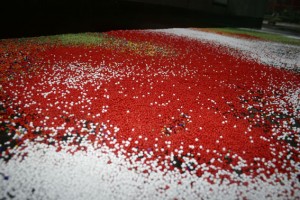« Features
A Conversation with Gabriela Maciel
By Biljana Ciric
Gabriela Maciel is a Brazilian artist and performer,? who participated in “A Starting Point: Intrude Art & Life 366,” at Zendai MoMA (Shanghai Zendai Museum of Modern Art)( January 18th - April 18th, 2009). Using diverse media, such as, painting, sculpture, installation, video and photography, she passed through different phases in her production, which started in the late 1990s. Gabriela’s creative concepts moved from expressions of a disturbing world of social disparities and a sense of displacement to historical clashes of culture and hybridism. Gabriela has been exhibiting since 2000. In many ways, she breaks through the boundaries of artistic expression by merging high-tech and low-tech and collaborating with artists worldwide.
BC: Can you tell me about your artistic process and the conceptual framework of your practice, especially the piece you produced in Shanghai?
GM: For some site-specific installations like The Cortex Wall of Brightness, for Intrude / MoMA, I start by making drawings of the work, inspirational drawings and technical studies. When I actually start working with the material, the on-site process of creation develops in ways different from those predicted in the drawings.
It’s a mixture of a time-based process, an almost performative act for the passersby in the surrounding space; the cultural influences of the country, which encounter my line of concept and aesthetic creation; the materials available for purchase; the textures and shapes of the architecture; the time alloted to production; the weather; the size of the space; the way people circulate and interact with the space. All of these aspects influence the creation of my site-specific installations.
In previous site-specific installations, from 2003 until 2007, I also produced on site during performances. Those performances were much more related to intense bodily movements and influenced by live digital sound, which was prerecorded, mixed and played live on site. I’ve also worked with digital video projection, overlaying the same installation in a different time, using the projection to light the performance installation, in an overlapping displacement of time and process, as audiences became immersed in the process.
Even today, it is not easy to comprehend my practice due to the profound mixture of media in the creative process and presentation of one piece. I deal with highly contemporary material produced in an extremely manual way or utilize cutting-edge techniques to transform ancient sources.
The ancient and the futuristic clash, time and processes are amplified, hyper-accelerated and sometimes overlaid.
Curiosity, estrangement, novelty, dreams and weirdness can be words to describe my work.
BC: How do you choose material for your sculptures of objects? Do you call them sculptures or objects? To me, they seem very organic in their shape but, at the same time, their color makes them artificial. How do you view this contradiction?
GM: This contradiction interests me. I think we live at a time when our DNA has stored information - in our unconscious impulses, creative minds and live bodies - since the dawn of man on through to the continuing evolution of man-machine. Furthermore, I believe this man-machine is getting farther away from his natural essence. As an artist, I play with the idea of what it is to be natural in a plastic world or what it is to be plastic in a natural world.
The pieces from 2003 through 2007 I refer to as creatures. The current pieces I call delirious chimeras; however, if I have to fill in the blank, I call them sculptures, because to me an object is something that you can buy in any shop for a specific use. The truth is that they are not objects, nor are they sculptures; the nomenclature could be assemblage. Perhaps a future nomenclature is being developed…?
BC: Where do you draw inspiration for shapes? It is a method of working that seems to be performative and process-based. It is all related to music, etc.
GM: My previous work, the creatures phase, was very influenced by music, but recently I’ve been searching through books of plants, animals and bodies, dealing with both ancient cultures and those in existence today.
Original shapes of nature converge into new beings in my creations. That’s why I’ve been giving them pseudoscientific names based on different language roots, such as Latin or other sources. Some recent pieces are entitled: Goticulae Sublimaris, Oceanis Flex, Cortex…
I’ve created a digital video in my new delirious chimeras phase in collaboration with an animation and sound artist, so the digital side of the delirious chimeras phase is growing too.
I can compare my entire art production to a body. One body is made up of several parts and each part has its own function. The body of my production is composed of drawings, paintings, sculptures, installations, digital videos, photos and sound, mixed media, multimedia. The languages blend in some parts; other parts are the extremities of one member, one media.
Using the example of The Cortex Wall of Brightness, I’ve assembled transparent plastic with foam, plastic fragments, graffiti paint, with every material matched, giving the piece a new aesthetic. It is almost hard to tell what it is made of, so the depth of the work relies on the hybridism of techniques, concepts and aesthetics.
Biljana Ciric is a curator based in Shanghai. She is the Director of Exhibition Programs, Ke Center for the Contemporary Arts www.kecenter.org and Curator of MoMA Shanghai / Intrude.



































